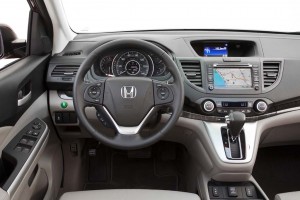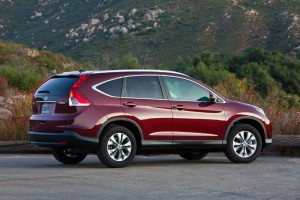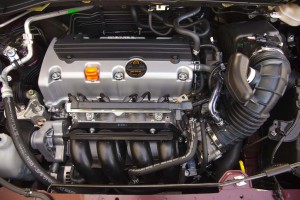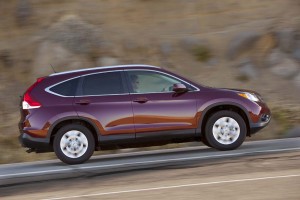The folks with the fancy MBAs like to call it the “first-mover advantage.” Discover a need or niche and fill it before the competition does. If your product resonates with consumers you’ll likely get a lock on the market.
And that’s precisely what happened when Honda introduced the original CR-V, 15 years ago, creating what is now one of the fastest-growing niches in the automotive market: the compact crossover. The Honda CR-V has been the perennial favorite among American shoppers – though the king has tumbled down the hill in recent months as the result of production shortages caused by the earthquake and tsunami that struck northeast Japan last March.
Now, as its plants slowly get back to normal, the Japanese maker is ready to roll out a fourth-generation of its compact CUV, but whether the 2012 Honda CR-V can regain its lead remains to be seen. It has a lot going for it, like an easy-to-use, 1-touch system for folding down the rear seats. But the crossover also suffers from a few glaring flaws — notably a numb new steering system — that could provide an opening for the next-generation 2012 Ford Escape, the outgoing domestic model already outselling the CR-V.
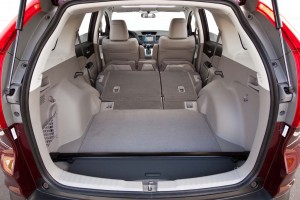
Open wide. Functionality - including a huge cargo bay - is a critical feature of the 2012 Honda CR-V.
The design of the new CR-V is a far cry from the mini-ute look of the original and the relatively boxy design of the last crossover. The 2012 model is more refined and, from some angles, a bit more wagon-like. The new, more curvaceous look has created something of a debate. A key goal was improving the new Honda CR-V’s aerodynamics – which translates into better mileage and less wind noise. Still, not everyone is pleased with the slightly droopy nose, which vaguely borrows from the Honda CrossTour, or the way the back of the cabin pinches in, but most existing CR-V owners will likely be comfortable with the overall look.
What’s surprising is that the new model appears bigger than the outgoing Honda CR-V even though it’s actually about an inch shorter overall, at 178.5 inches, and an inch lower, at 65.1 inches. What will matter more is that Honda has done a better job of utilizing space, the 2012 model boasting more room in just about every category that counts for passengers and cargo.
That underscores the functionality of the new CR-V. The large cargo compartment becomes positively cavernous when you fold down the rear seats and doing that is incredibly easy. Perhaps the single feature more folks kept talking about on our recent media drive was the new single-touch lever that easily tumbled the second-row seats forward, creating a nice, flat load floor that stretches 61.4 inches – five more than before — and offers a total 37.2 cubic feet of space.
Meanwhile, Honda has expanded the size of the center console creating a storage space large enough for a woman’s purse, adding even larger cupholders and a separate space for a large water bottle.
The design of the instrument panel has also been updated, with more vertical controls and a nicely integrated navigation display. The 5-inch multi-information display, or MID, is reasonably easy to use, especially with the redundant steering wheel-mounted control. Among the new features, the infotainment system now pairs with a smartphone to access the Pandora audio service and it can read out text messages while allowing the driver to respond with one of six pre-set messages.
The MID screen can display the new Multi-Angle Rearview Camera, the driver able to switch between a 130-degree image, a 180-degree image or an image that appears to be taken from overhead.
But as with the much-maligned 2012 Honda Civic, we have to quibble with the automaker’s approach. There’s still a fair bit too much hard plastic in the new model’s interior. And, as our driving colleague discovered, it’s easy to put a mark onto the surface of the IP with a fingernail that won’t readily come out.
In an industry that has discovered the critical importance of interior upgrades Honda has lately been moving a bit backwards. The 2012 CR-V does offer a more functional cabin but not necessarily one that looks more expensive or lavishly detailed.
On the mechanical front, the new 2012 Honda CR-V now features Hill-Start Assist to prevent the vehicle from rolling back when you start moving on a hill. And there’s a revised All-Wheel-Drive system the maker claims is smoother, more efficient and lower weight, helping enhance fuel economy.
The new CR-V’s 2.4-liter inline-four engine is smooth and responsive, delivering excellent fuel economy for a compact crossover, even the all-wheel-drive model reaching 30 mpg (US) on the highway. But Honda seems to have taken a “good enough” approach, opting for port fuel injection where the competition offers direct injection, and a 5-speed gearbox where 6, 7, even 8-speeds are becoming the norm. T
To give the maker its due, the package achieves a reasonably impressive 22 mpg City, 30 Highway and 25 Combined in the EPA test cycle for the AWD model, 23/31/26 for the front-wheel-drive CR-V. Yet the numbers alone don’t hide the fact that Honda now seems more driven than anything to hold down costs in a world where the yen is horribly out of balance against the dollar. What happened to the Honda that once billed itself as an engine company that also made cars and led the world in powertrain innovation?
The powertrain may not be state-of-the-art, but it’s not going to bother the typical CR-V driver. What will is likely the new electric power steering system, the source of our single biggest complaint about the 2012 Honda CR-V. It may save fuel but it is entirely disconnected from the road and requires too much sawing as you work your way around the corners. It simply kills the fun-to-drive factor in our mind, an many of our colleagues seemed to have the same complaint – which is too bad because the overall ride is reasonably pleasant with relatively little body roll.
Is that enough to tell customers to, er, steer clear of the new 2012 Honda CR-V? No, especially not for those who focus more on basic functionality and less on the joy of driving. The newly-updated crossover handles that well, though it just doesn’t move the state of the art much forward beyond the nifty little rear seat release.
And we’ll wait to see if that’s enough to counter the trick proximity sensing system Ford will offer on the next-gen Escape, which allows you to simply wiggle a foot beneath the rear bumper to open the tailgate if your hands are filled with bags. Honda doesn’t even have a power tailgate.
Nonetheless, with a solid record of reliability and the likelihood it will again get a top crash rating from federal safety regulators, the 2012 Honda CR-V should win back most loyal owners. Whether it will continue to “conquest” customers from other brands is more uncertain than with past models, however, what with so many other competitive offerings hitting the street.


